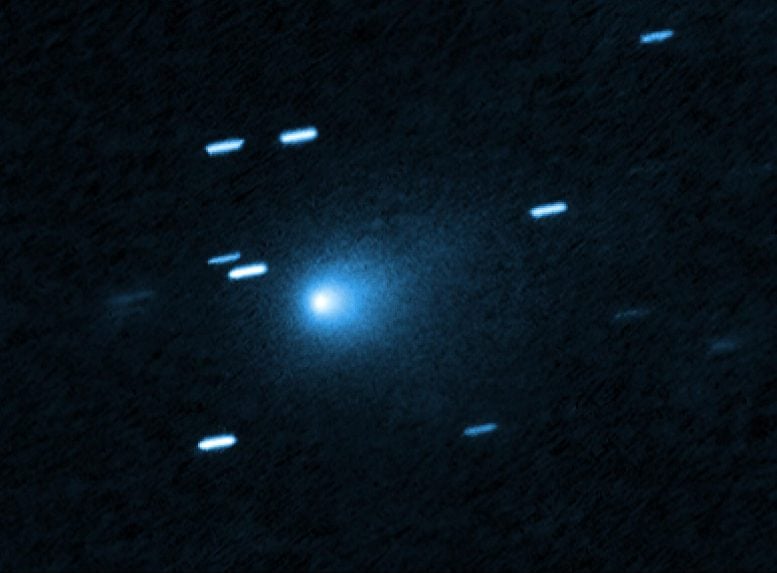This is a Hubble Space telescope image of the interstellar comet 3I/ATLAS. Hubble photographed the comet on July 21, 2025, when the comet was 365 million kilometres from Earth. Hubble shows that the comet has a teardrop-shaped cocoon of dust coming off its solid, icy nucleus. Because Hubble was tracking the comet moving along a hyperbolic trajectory, the stationary background stars are streaked in the exposure. Credit:
NASA, ESA, D. Jewitt (UCLA); Image Processing: J. DePasquale (STScI)
NASA’s Hubble Space Telescope has captured the sharpest-ever view of the interstellar comet 3I/ATLAS, revealing clues about its icy nucleus, high-speed journey, and dust activity as it races through the solar system.
Traveling at a record-breaking 130,000 mph, the comet is thought to have spent billions of years drifting through interstellar space before arriving in our cosmic neighborhood.
The Sharpest-Ever Look at a Cosmic Visitor
Astronomers have captured the most detailed image yet of the interstellar comet 3I/ATLAS using NASA’s Hubble Space Telescope. Hubble is one of several observatories in NASA’s fleet assigned to study the comet, working together to uncover new details about its size and physical features. Although 3I/ATLAS poses no danger to Earth, these efforts are part of NASA’s broader mission to detect, track, and understand objects that travel near our planet.
Data from Hubble is giving researchers a clearer picture of the comet’s icy, solid core. Current measurements place the nucleus at no larger than 3.5 miles (5.6 kilometers) across, though it could be as small as 1,000 feet (320 meters). While Hubble has narrowed down the size more precisely than earlier ground-based observations, even its powerful optics cannot directly reveal the solid center. Other NASA missions, such as the James Webb Space Telescope , TESS (Transiting Exoplanet Survey Satellite), and the Neil Gehrels Swift Observatory , along with the W.M. Keck Observatory, are expected to provide additional insights into the comet’s composition and chemistry.
Dust Plumes and Solar Heating
Hubble also detected a plume of dust erupting from the sunlit side of the comet and a faint dust tail trailing behind it. The dust-loss rate appears consistent with comets that are usually discovered around 300 million miles from the Sun, resembling the activity of comets born within our own solar system.
What sets 3I/ATLAS apart is its origin. This icy traveler began its journey in another solar system somewhere within the Milky Way before crossing into ours.
Right now, 3I/ATLAS is racing through the solar system at an astonishing 130,000 miles (209,000 kilometers) per hour, the fastest speed ever observed for an object of its kind. Astronomers believe this extraordinary velocity reflects its long journey through interstellar space. Over billions of years, the comet has been accelerated by gravitational encounters with stars and nebulae, each interaction gradually increasing its momentum until it reached its current record-breaking pace.
Tracing the Origins—If Possible
“No one knows where the comet came from. It’s like glimpsing a rifle bullet for a thousandth of a second. You can’t project that back with any accuracy to figure out where it started on its path,” said David Jewitt of the University of California, Los Angeles, science team leader for the Hubble observations.
The paper will be published in The Astrophysical Journal Letters . It is already available on Astro-ph.
This image of interstellar comet 3I/ATLAS was captured by the Hubble Space Telescope’s Wide Field Camera on July 21, 2025.
The scale bar is labeled in arcseconds, which is a measure of angular distance on the sky. One arcsecond is equal to an angular measurement of 1/3600 of one degree. There are 60 arcminutes in a degree and 60 arcseconds in an arcminute (the full Moon has an angular diameter of about 30 arcminutes). The actual size of an object that covers one arcsecond on the sky depends on its distance from the telescope.
The north and east compass arrows show the orientation of the image on the sky. Note that the relationship between north and east on the sky (as seen from below) is flipped relative to direction arrows on a map of the ground (as seen from above).
This image shows visible wavelengths of light.
Credit: NASA, ESA, D. Jewitt (UCLA); Image Processing: J. DePasquale (STScI)
A New Class of Interstellar Visitors
“This latest interstellar tourist is one of a previously undetected population of objects bursting onto the scene that will gradually emerge,” said Jewitt. “This is now possible because we have powerful sky survey capabilities that we didn’t have before. We’ve crossed a threshold.”
This comet was discovered by the NASA-funded Asteroid Terrestrial-impact Last Alert System (ATLAS) on July 1, 2025, at a distance of 420 million miles from the Sun. ATLAS is an asteroid impact early warning system developed by the University of Hawai’i.
In the meantime, other NASA missions will provide new insight into this third interstellar interloper, helping refine our understanding of these objects for the benefit of all. 3I/ATLAS should remain visible to ground-based telescopes through September, after which it will pass too close to the Sun to observe, and is expected to reappear on the other side of the Sun by early December.
Reference: “Hubble Space Telescope Observations of the Interstellar Interloper 3I/ATLAS” by David Jewitt, Man-To Hui, Max Mutchler, Yoonyoung Kim, Jessica Agarwal, accepted, The Astrophysical Journal Letters.
arXiv:2508.02934
Never miss a breakthrough: Join the SciTechDaily newsletter.
https://scitechdaily.com/hubble-reveals-a-rare-interstellar-comet-racing-at-130000-mph-through-our-solar-system/





